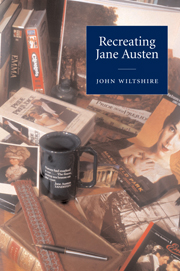Book contents
- Frontmatter
- Contents
- Preface and acknowledgments
- A note on texts
- Introduction: ‘Jane Austen’ and Jane Austen
- 1 Imagining Jane Austen's life
- 2 Recreating Jane Austen: Jane Austen in Manhattan, Metropolitan, Clueless
- 3 An Englishwoman's constitution: Jane Austen and Shakespeare
- 4 From drama, to novel, to film: inwardness in Mansfield Park and Persuasion
- 5 Pride and Prejudice, love and recognition
- 6 The genius and the facilitating environment
- Notes
- A note on films cited
- Bibliography
- Index
3 - An Englishwoman's constitution: Jane Austen and Shakespeare
Published online by Cambridge University Press: 22 September 2009
- Frontmatter
- Contents
- Preface and acknowledgments
- A note on texts
- Introduction: ‘Jane Austen’ and Jane Austen
- 1 Imagining Jane Austen's life
- 2 Recreating Jane Austen: Jane Austen in Manhattan, Metropolitan, Clueless
- 3 An Englishwoman's constitution: Jane Austen and Shakespeare
- 4 From drama, to novel, to film: inwardness in Mansfield Park and Persuasion
- 5 Pride and Prejudice, love and recognition
- 6 The genius and the facilitating environment
- Notes
- A note on films cited
- Bibliography
- Index
Summary
His plays are out of joint; O cursed sprite!
That ever I was born to set them right!
Arthur Murphy, Hamlet with Alterations: a Tragedy in Three Acts
Not long ago, the traveller in England was confronted everywhere – on railway stations, in bookshops, on hoardings and placards – with a message advertising Penguin Classics: ‘Two Heads are Better than One’. The coarsely represented male face (high forehead, long hair, high collar) was juxtaposed with an equally blurred female one (lace collar, curls peeking out of cap). With the crudity of images reproduced, and reproduced again, these faces seemed to have not the idiosyncrasy of individuals but the replicability of trademarks. It was not the merging together of these two icons that signalled their equivalence, so much as their familiarity, the expectation broadcast so clearly that if there were two writers whose images the British railway-travelling, and bookshop-frequenting, public would be sure to recognise, these were they – William Shakespeare and Jane Austen.
The association of Shakespeare's and Austen's images and names might well be said to belong to the history of promotion rather than of critical history. If you were concerned, as many of Austen's nineteenth-century critics may well have been, that the object of your enthusiasm – her world so circumscribed, her range so narrow – met none of the heroic criteria for great writing, what better defence than the use of Shakespeare's name?
- Type
- Chapter
- Information
- Recreating Jane Austen , pp. 58 - 76Publisher: Cambridge University PressPrint publication year: 2001

